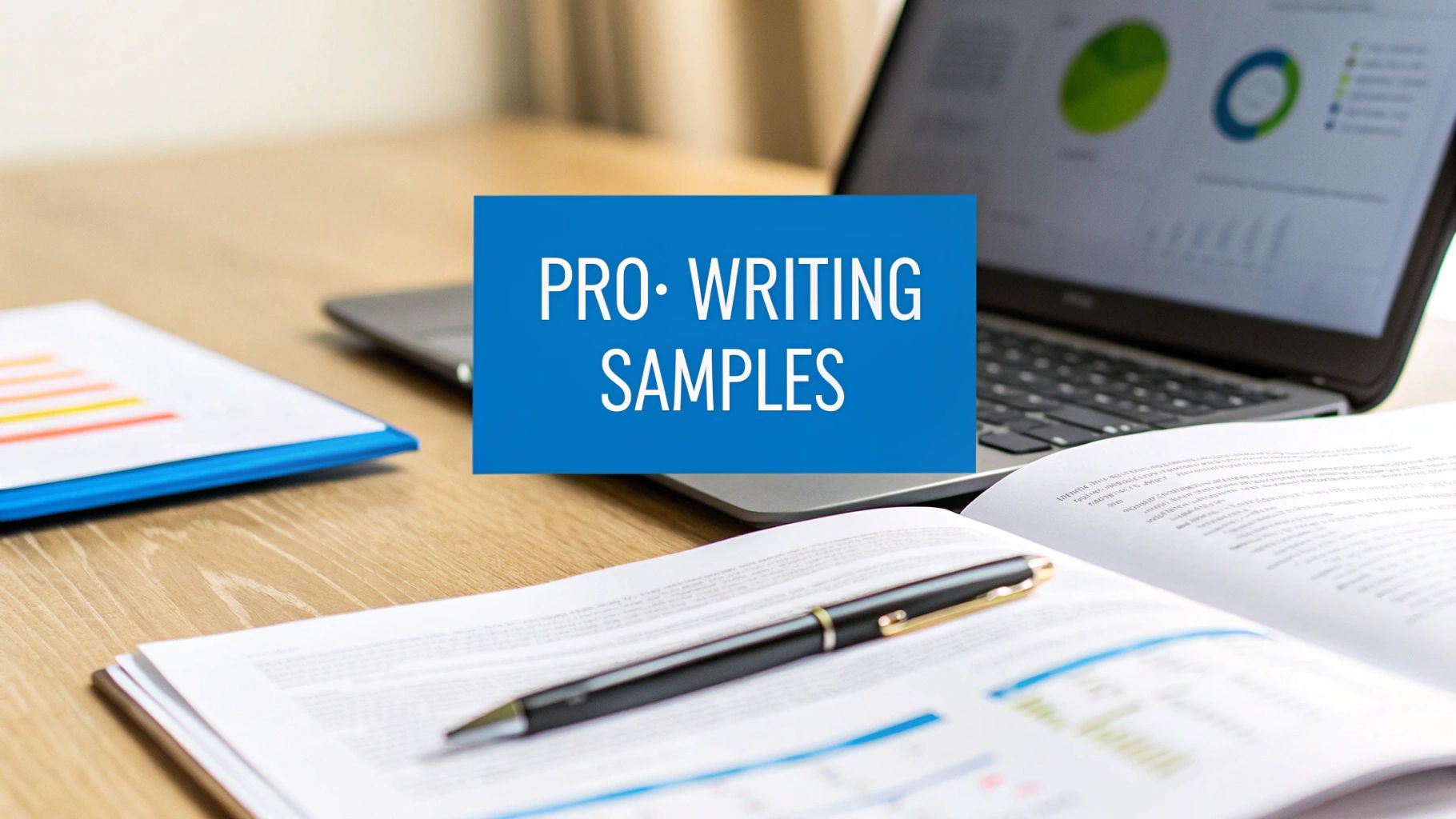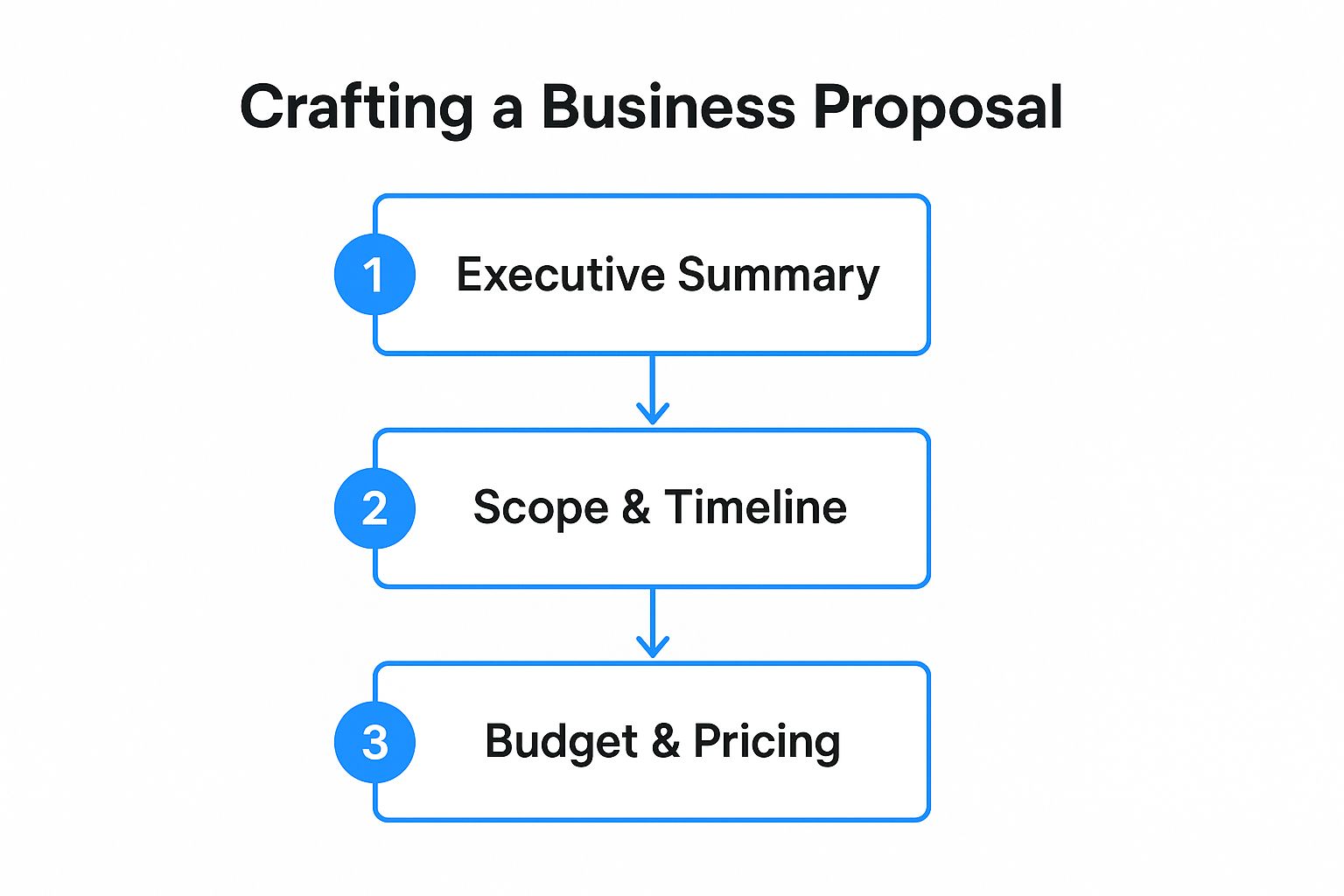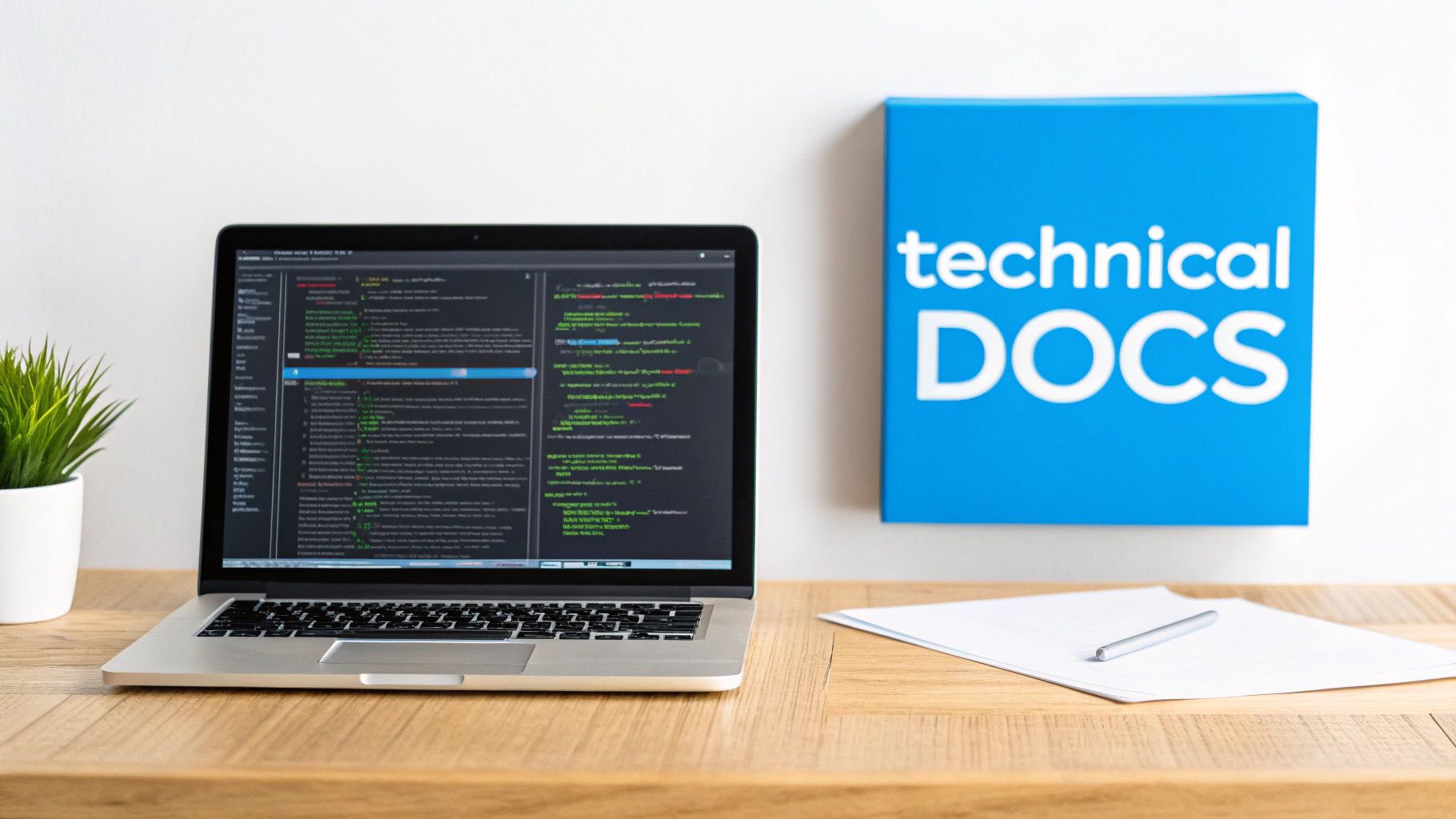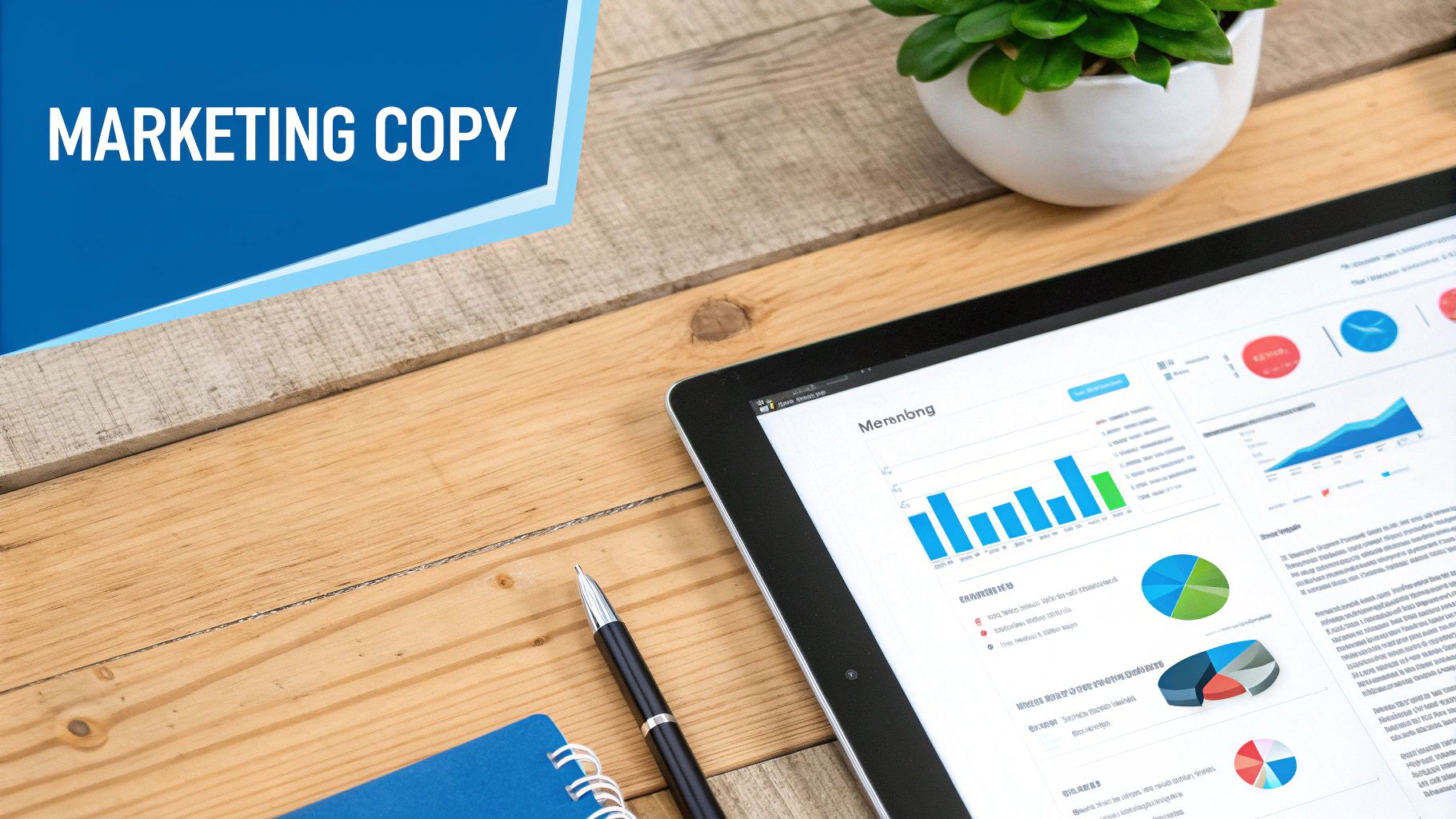Top 6 Professional Writing Samples to Boost Your Career in 2025

In today's competitive landscape, the ability to communicate with clarity and persuasion is non-negotiable. Strong writing isn't just about avoiding typos; it's a strategic tool for influencing decisions, securing funding, and building your professional reputation. Yet, many struggle to find high-quality examples to guide their efforts. This article bridges that gap by providing a deep dive into six diverse professional writing samples.
We'll move beyond generic advice and break down the specific strategies, structures, and psychological triggers that make these documents effective. You will learn to deconstruct what works and how to apply these winning formulas to your own projects, whether you're crafting a business proposal, a technical guide, or compelling marketing copy. Ultimately, the core reason for focusing on these examples is to improve your writing skills for career advancement and open new doors. Let's begin.
1. Business Proposal
A business proposal is a persuasive document designed to secure a project, partnership, or investment. Unlike a simple price quote, it’s a comprehensive sales tool that articulates a clear value proposition, outlines a strategic solution, and details the project's scope, timeline, and costs. This is one of the most critical professional writing samples because it directly translates writing skill into revenue and business growth.
Effective proposals, like those from top-tier consulting firms such as McKinsey or Deloitte, don't just list services; they diagnose a client's problem and present a compelling, data-backed plan to solve it. They blend persuasive narrative with hard facts to build trust and demonstrate expertise.
Strategic Breakdown
The core of a winning proposal is its client-centric approach. It must immediately address the client’s needs and goals, showing you understand their unique challenges. Every section should reinforce why your solution is the best choice.
- Lead with an Executive Summary: This is your elevator pitch. It must be powerful enough to make the reader want to continue.
- Focus on Benefits, Not Features: Instead of saying, "We offer social media management," say, "We will increase your lead generation by 30% through targeted social media campaigns."
- Incorporate Social Proof: Use case studies, data, and testimonials to validate your claims and reduce perceived risk for the client.
- Include a Clear Call-to-Action (CTA): Guide the reader on the exact next steps, whether it's signing a contract, scheduling a call, or clicking a payment link.
The infographic below illustrates the foundational structure of crafting a compelling proposal.
This sequence creates a logical flow, starting with a high-level overview, moving to the specific project details, and concluding with the financial investment required.
2. Technical Documentation
Technical documentation refers to structured written materials that explain how to use, configure, or understand a complex product, system, or process. It serves as a critical bridge between technical complexity and user comprehension, making it an essential professional writing sample that demonstrates clarity, precision, and user-centric thinking. Good documentation reduces support tickets, improves user adoption, and empowers customers to succeed.
Industry leaders like Stripe, with their renowned API documentation, and Atlassian, with their extensive Confluence user guides, prove that great documentation is a competitive advantage. They treat their technical content not as an afterthought but as a core part of the product experience, designed for clarity, searchability, and ease of use.
Strategic Breakdown
The best technical documentation is built on a foundation of empathy for the user. It must anticipate the user's questions, skill level, and goals, organizing complex information into a logical, easy-to-navigate structure. Every guide, tutorial, or reference should be designed to solve a user's problem as efficiently as possible.
- Prioritize a Clear Information Architecture: Organize content logically with clear headings, a table of contents, and robust search functionality so users can find answers fast.
- Maintain Absolute Consistency: Use consistent terminology, formatting, and tone throughout all documents to prevent confusion and build user trust.
- Incorporate Visual Aids: Use screenshots, diagrams, and videos to illustrate complex steps and break up dense blocks of text.
- Update Relentlessly: Documentation must evolve with the product. A process for regular updates is crucial to ensure accuracy and relevance.
The video below explains the core principles that guide the creation of effective and user-friendly technical documentation.
This strategic approach transforms documentation from a simple instruction manual into a powerful tool for user education and product adoption. For those looking to streamline this process, you can learn more about how to enhance clarity in your technical writing on word-spinner.com.
3. Case Study Report
A case study report is an in-depth analysis that examines a specific business situation, project outcome, or problem-solving process to demonstrate expertise and tangible results. More than a mere testimonial, it is a powerful marketing asset that provides concrete, narrative-driven evidence of success. This type of professional writing sample is crucial for building credibility and trust, as it translates your company's value into a client's success story.
Top-tier examples, like HubSpot's marketing automation studies or IBM's AI implementation reports, follow a proven formula. They don’t just praise their own products; they meticulously document a client's journey from a significant challenge to a measurable, positive outcome. This blend of storytelling and data makes them persuasive and memorable.
Strategic Breakdown
An effective case study centers entirely on the client’s transformation. It must be structured to guide the reader through a logical progression: the initial problem, the implemented solution, and the ultimate results. The narrative should position your company as the catalyst for the client's success, not the hero of the story.
- Follow the Problem-Solution-Result Framework: Clearly articulate the client’s pain point, detail the specific strategies you deployed, and showcase the quantifiable achievements.
- Use Specific, Measurable Outcomes: Instead of saying "sales improved," state "we increased quarterly sales revenue by 45%." Hard numbers provide undeniable proof of value.
- Incorporate Direct Client Quotes: Weave in quotes from key stakeholders to add authenticity and provide a human element to the data. This builds social proof and makes the story more relatable.
- Design for Skimmability: Use headings, bullet points, and callout boxes to highlight key statistics and takeaways, ensuring even busy readers can grasp the core message quickly.
This structure allows potential customers to see themselves in the story, making it easier for them to envision achieving similar results by partnering with you.
4. Grant Writing Proposal
A grant writing proposal is a highly specialized form of persuasive writing used to request funding from entities like foundations, government agencies, or corporations. Unlike a standard business proposal, it is less of a sales tool and more of a meticulously structured argument for support, blending compelling narrative with rigorous data to demonstrate a project’s potential for social, scientific, or community impact.
These documents, such as proposals for National Science Foundation grants or the Gates Foundation, are among the most demanding professional writing samples. They require strict adherence to funder guidelines and a powerful story that connects a problem with a viable, evidence-backed solution. This type of writing directly enables critical research, non-profit operations, and innovative projects.
Strategic Breakdown
A successful grant proposal is built on a foundation of thorough research and a deep understanding of the funder's mission. The entire document must be framed around the funder's priorities, showing how your project aligns perfectly with their goals. To truly master grant writing, studying successful examples can provide invaluable insight into structure and persuasion; these 6 powerful grant writing samples offer a strong starting point.
- Follow Guidelines Precisely: Grant applications are often disqualified for minor deviations. Meticulous attention to formatting, word counts, and required attachments is non-negotiable.
- Show, Don't Just Tell the Need: Use compelling statistics, stories, and data to create a powerful case for why the problem you are addressing requires urgent attention.
- Clearly Define Measurable Outcomes: Funders need to see a return on their investment. Clearly articulate what success looks like with specific, measurable, achievable, relevant, and time-bound (SMART) goals.
- Build a Relationship First: When possible, connect with program officers before submitting. This can provide crucial insights and demonstrate your organization's professionalism.
Given the detail required, writers often wonder about using AI tools. You can learn more about the ethics of using ChatGPT for grant writing to understand its potential benefits and pitfalls.
5. Marketing Copy and Content
Marketing copy is the persuasive written material designed to promote a product, service, or brand across various channels. It combines psychology, strategic messaging, and storytelling to drive specific consumer actions, from making a purchase to joining a newsletter. This type of professional writing sample is vital because it directly influences consumer behavior and revenue generation.
Iconic examples, like Nike's "Just Do It" campaign or Dollar Shave Club's witty web copy, demonstrate how powerful words can be in building a brand identity. Great marketing copy doesn't just sell a product; it sells an experience, a solution, or an aspirational identity, making it a powerful asset in any professional portfolio.
Strategic Breakdown
Effective marketing copy is always audience-first. It must resonate with the target consumer's desires, pain points, and language. The goal is to make the reader feel understood and present the product or service as the clear and obvious solution to their needs. As content demands increase, marketers are exploring new ways to produce compelling materials; you can discover how to create content using AI to support these efforts.
- Focus on Benefits Over Features: Instead of listing specs, explain how the product improves the customer's life. "Our vacuum has a HEPA filter" (feature) becomes "Breathe cleaner air and reduce allergens in your home" (benefit).
- Use a Clear and Consistent Brand Voice: Whether your brand is authoritative, playful, or empathetic, maintain that tone across all touchpoints to build a recognizable and trustworthy identity.
- Incorporate a Compelling Call-to-Action (CTA): Every piece of copy should guide the user toward a specific next step. Use strong, action-oriented language like "Get Your Free Trial" or "Shop the Collection Now."
- Leverage Social Proof: Integrate testimonials, user reviews, or case study data directly into the copy to build credibility and ease potential customer hesitation.
6. Executive Summary and Business Reports
An executive summary or business report is a high-level document that distills complex information for senior leadership and key stakeholders. It’s not just a shorter version of a longer report; it's a strategic tool designed for rapid comprehension and decision-making. This type of professional writing sample is crucial because it demonstrates the ability to synthesize data, identify key insights, and communicate critical information efficiently.
Top-tier examples, like the market research summaries used to greenlight product launches or the annual report summaries for shareholders, prioritize clarity and impact. They answer the "so what?" question immediately, enabling busy executives to grasp the core message without wading through exhaustive details.
Strategic Breakdown
The power of a great executive summary lies in its "bottom line up front" (BLUF) approach. It must immediately deliver the most critical conclusions and recommendations, ensuring the primary message is understood even if the reader stops after the first paragraph.
- Lead with Key Findings: Start with the conclusion or most important recommendation. Don't build up to it; state it directly.
- Use Data Strategically: Include only the most essential metrics that directly support your findings. Avoid overwhelming the reader with secondary data.
- Write for the Audience: Tailor the language, tone, and level of detail to the specific stakeholders. A summary for the board of directors will differ from one for a project team.
- Provide Clear Next Steps: Conclude with actionable recommendations or clear decision points, guiding the reader on what to do with the information. For a wider array of examples and customizable structures, explore these essential business document templates.
Mastering the art of brevity and clarity in these documents is a highly valued professional skill. You can learn more about crafting these high-stakes documents by exploring how to refine business reports.
Professional Writing Samples Comparison
| Document Type | Implementation Complexity 🔄 | Resource Requirements 💡 | Expected Outcomes 📊 | Ideal Use Cases 💡 | Key Advantages ⭐ |
|---|---|---|---|---|---|
| Business Proposal | High – detailed, multi-sectioned | Extensive research, analysis, and writing | Formal agreement, clear project roadmap | Client pitches, partnerships, project bids | Professionalism, legal backing, strategic clarity |
| Technical Documentation | Moderate to High – ongoing updates | Skilled writers, visual aids, maintenance | User understanding, reduced support burden | Software guides, training, troubleshooting | Improves user adoption, reusable resource |
| Case Study Report | Moderate – data gathering, narrative | Data collection, client collaboration | Credibility, demonstrated ROI, marketing content | Showcasing success, proof of expertise | Builds trust, strong social proof |
| Grant Writing Proposal | High – detail-oriented, guideline-driven | In-depth research, strict compliance | Secured funding, organizational partnerships | Nonprofits, research, project funding | Access to funds, detailed project planning |
| Marketing Copy and Content | Low to Moderate – creative and iterative | Creative teams, testing tools | Increased conversions, brand engagement | Advertising, digital marketing | Fast turnaround, measurable impact |
| Executive Summary & Business Reports | Moderate – concise synthesis | Analytical skills, data visualization | Informed decision-making, strategic direction | Senior leadership briefings, investor updates | Efficient communication, strategic insights |
From Sample to Success: Your Next Steps
We've journeyed through a diverse landscape of professional writing samples, from the persuasive logic of a business proposal to the crisp clarity of an executive summary. Moving beyond these examples requires applying their underlying principles to your own work. The most effective professional writing isn't about memorizing formats; it's about mastering a strategic thought process.
This process rests on a few core pillars we've seen in every successful document:
- Audience-Centricity: Who are you writing for, and what do they need to know or feel?
- Purpose-Driven Structure: Does your document’s architecture guide the reader to your intended outcome?
- Clarity and Precision: Is every sentence concise, direct, and free of ambiguity?
As you approach your next writing task, don't just start writing. Pause and ask these questions first. Use the examples in this article as a strategic blueprint. Revisit the breakdown of the case study before you write your next success story, or review the grant proposal's structure to organize your own pitch for funding. Each sample is a masterclass in combining logic with persuasion.
The true value of these professional writing samples is their replicable strategy. The techniques for building trust in a technical document or creating urgency in marketing copy are not secrets; they are skills you can develop through deliberate practice. By consciously applying these frameworks, you transform writing from a routine task into your most powerful tool for influencing decisions, building credibility, and driving results. Your journey from seeing a sample to achieving success begins with the very next document you create.
Ready to elevate your own documents from drafts to powerful professional assets? Word Spinner can help you refine your message with precision. Use it to humanize AI-generated text or rephrase your own writing for maximum clarity and impact, ensuring every word serves its purpose. Try Word Spinner today to bring professional polish to your writing.


